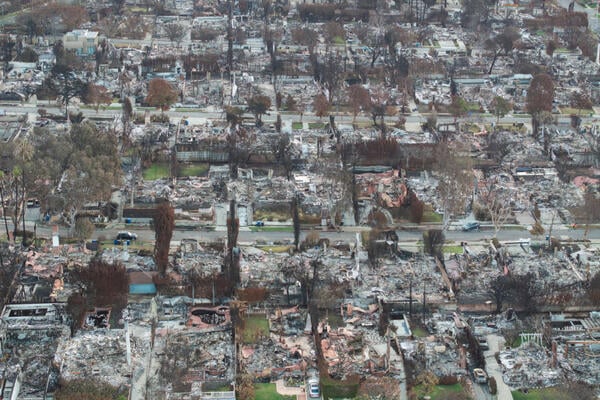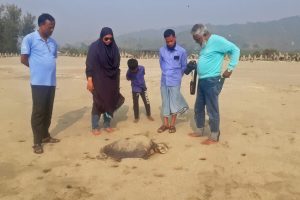The summer after the COVID-19 pandemic began, Glendale Community College in California launched its basic needs department with a staff of one, in the hopes that the university would be well positioned to support its students if another disaster came to pass.
Four and a half years later, one did: Wildfires erupted in Los Angeles and the neighboring suburbs in January, destroying roughly 13,000 houses, including many inhabited by GCC students and their families. Students also lost jobs and cars due to the blazes. Others kept their homes but had to evacuate for multiple weeks.
The basic needs department, charmingly called GCC CARES—shorthand for the Center for Assistance, Resources and Educational Success—sprang into action. Now supported by a full-time staff of 10, as well as nearly 70 Americorps fellows, the office began by working with corporate partners like DoorDash and Target to give students gift cards they could use to access necessities. Within weeks, they were distributing direct disaster relief to those impacted—$1,000 for anyone who was evacuated and $2,000 for anyone who had lost their home.
While much of the assistance was funded by donations made in the immediate aftermath of the fire, GCC CARES also had money in an endowed fund—built up from donations, grants and monthly contributions from about 100 GCC employees—for such an occasion.
“For the last four and a half years of having a basic needs department, we knew that a crisis like this was ultimately going to happen. We didn’t know what it was or when it was going to be, but we knew it was going to happen,” said Andre Manukyan, who has led GCC CARES since its founding—and who also contributed the initial donation to the fund. “Part of my responsibility was making sure that we had sufficient funding within the foundation. Over that four-and-a-half-year period, we had, separate from the fire response, raised about $1.4 million.”
Six weeks later, their work isn’t over. GCC CARES will launch the next phase of its fire aid next month, offering income-based rental assistance to displaced students through the end of 2025. Manukyan and his team are still tracking down students who might benefit from the program, comparing publicly available data about which houses burned to GCC student information.
“We haven’t yet identified all the students that are impacted,” he said. Just over a week ago, “I found 16 more students who lost their houses.”
Louisiane Marie-Tardon, a second-year student at Santa Monica College, whose family home burned in the Palisades wildfire, is one of the many students who benefited from financial assistance from her institution amid the disaster. She went without reliable housing for about a month, bouncing between friends’ residences while simultaneously working to finish two winter courses, unsure if or when she would be able to return to her home.
“I saved my mother’s jewelry, for example, but that’s the only thing I took from the house. Because, first of all, I didn’t think it was going to be the last time I would go to my house,” she recalled.
The most helpful support she received during the disaster, she said, was tuition assistance from the college. The funds were a weight off her back as she reckons not only with expenses associated with the fire, but also with the anticipated costs of transferring to a four-year institution next year—the University of California, Los Angeles, she hopes.
Now in her last semester at Santa Monica College, she is staying in a three-month rental apartment, waiting to see what the future holds.
The Trauma of Disaster
The wildfires in Los Angeles came only months after another once-in-a-lifetime natural disaster, Hurricane Helene, hit the Southeast United States in September, wiping out entire towns in western North Carolina, an area rarely impacted by hurricanes. There, too, college leaders worked to support students who lost their income, housing or transportation.
Scientists say climate change has led to more extreme weather patterns, resulting in an increased number of natural disasters and a greater likelihood of fires and floods hitting areas—and campuses—that aren’t accustomed to such disasters. The effects likely won’t be limited to damaged campus buildings or even students’ mental and physical well-being; research shows that natural disasters and their aftereffects can also have a negative impact on students academically. They may struggle to commute to and from class if their transportation was impacted by the disaster, for example, or to complete assignments if they are left without power or internet connection.
The psychological impacts of trauma after a natural disaster can also impact a person’s ability to focus or manage their emotions, according to Christen Rinaldi, a certified disaster mental health counselor who helped train staff and faculty to support students at Asheville-Buncombe Technical Community College, which suffered flooding in the wake of Hurricane Helene.
“Trauma from disaster shows up a little bit differently,” she said. “Sometimes we think it hasn’t impacted us, but it might show up in tricky ways.”
Kerri Glover, a spokesperson for A-B Tech, the largest community college in western North Carolina, said that 614 students withdrew from fall semester classes in the hurricane’s aftermath. But administrators believe that number would be much higher—as many as 2,000 out of the institution’s 6,500 degree-seeking students—had the institution not handed out over $1 million in tuition assistance.
A-B Tech president John Gossett told Inside Higher Ed that most of those students appear to have returned for the spring semester.
“When I’ve talked to students, anecdotally, they’re excited about being back on campus, which tells me that their personal lives are squared away-—as squared away as they can be, right?—and they’re looking forward to coming back, getting the education and getting on with their lives,” he said.
Rinaldi said it’s not unusual to feel relief at returning to normalcy after a natural disaster.
“That is the No. 1 thing we will tell parents with children during the disaster time period, especially immediately following—try to make things as normal as possible. Whatever your family routine is—if you’re in a hotel, do your bedtime routine,” she said. “Familiarity provides us with a sense of security. It keeps our nervous system regulated if we know what to expect, because going through a natural disaster has sort of blown up our sense of safety.”
Far-Reaching Effects
Students say the disasters have continued to affect them in the weeks and months that followed—but also that having a sense of normalcy on campus has been a boon.
For Grace Buckner, a first-year graduate student who commutes twice a week to Appalachian State University from a small town called Marshall in Madison County, N.C., the storm’s impact on her life and schoolwork was far-reaching. Once it started, Buckner, who is studying English and library science, found herself stranded away from home for days on end—first in Boone, where App State is located, and then in Winston-Salem once Boone flooded. She was unable to get in touch with her family back in Marshall.
Eventually, she was able to take “this insane, convoluted route to get up to Madison County that normally would take me about three hours—it took me about six.” There she lived for days with little connection to the outside world, including her university and her professors; the only place to get a signal in town was in a heavily trafficked grocery store parking lot.
App State, which had closed following the flooding, resumed classes in mid-October, but Buckner still couldn’t get back to Boone due to road closures.
“I had to get in touch with professors and be like, ‘I really don’t know, I’m not sure, I’ve got this other route, but it’s crazy long, like, there’s no way this is going to work,’” she recalled. “Basically, in the first week, I just did Zoom classes. By the next week, the roads were open enough that I could get there. It was just a little bit longer. It was a pretty scary drive.”
She’s still dealing with the impact of the flooding; she lost her job working at a library in her county, which was destroyed in the hurricane, although her on-campus graduate assistantship has provided her with income in the interim.
“The university did a good job of, I guess, giving a sense of normalcy at a time when nothing was normal,” she said.







